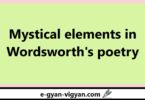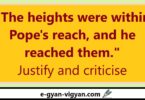
“He gathered his notions fresh from reality, not from the copies of authors but from the originals of Nature.” Discuss Pope’s view of nature, and show how Pope followed nature
“He gathered his notions fresh from reality, not from the copies of authors but from the originals of Nature.” Discuss Pope’s view of nature, and show how Pope followed nature
Pope presents his view of Nature in Essay on Criticism. By nature he meant human nature. For him the proper study of mankind is man. In his poetry, Pope has given us his philosophy of human nature, and not the philosophy of nature (the world of trees, hills and rivers) as Wordsworth could possibly give. He was the poet of human personality and of polished life. We read in his poetry about fashions and fashions of conventional society.
What he meant by his doctrine of “follow Nature” was that the rules which ought to be observed by an artist in his poetic composition must be studied in the works of the great classical writers. In other words, the artist should follow the rules and regulations which have been laid down by the ancients. According to Saintsbury, Pope meant that an artist should stick to the usual, the ordinary, the commonplace.
The Essay on Criticism was an effort to codify the new law of Renaissance with regard to poctical imitation. It is divided into three sections. In the first, Pope dwells upon chaotic state of criticism in his days and the many abuses of the art which consequently prevail, lays down his main rule of following Nature: and explains that the rules to be observed must be studied in the works of the great classical writers because this way of proceeding is ‘Nature still, but Nature methodised.’ In the second section of the Essay which is much the finest, he illustrates the necessity of his doctrine by many examples of False wit, and produces his famous definition of true wit in the following manner :
Nature to advantage dressed
What oft was thought, but ne’er so well expressed.
In the third section he describes the character of the good critic and gives an historical sketch of those who have most distinguished themselves in the art, closing it with an elegant compliment to Walsh, who as he told Spence, was the first to advise him to aim at “correctness”. The execution of the central design is very irregular the arrangement being often confused and particular thoughts so unconnected as to leave the impression that the epigrams have been produced without method. But he has dressed them so neatly, and turned them out with such sparkle and point. that these truisms have acquired a weight not their own, and they circulate as proverbs among us in virtue of their pithy form rather than their truth. They exemplify his own line, ‘what oft was thought, but ne’er so well expressed.” The Essay abounds in those striking couplets which have lodged in our memories for long. Such are: “For fools rush in where angels fear to tread”, “To err is human, to forgive divine” “For forms of government let fools quarrel…… “A little learning is a dangerous thing”, and many more like them.
English – Important links
- Hero of ‘Paradise Lost’ | Hero of Milton’s ‘Paradise Lost’ | Who is the hero of ‘Paradise Lost’
- A note on Milton’s Grand style
- Paradise Lost as a classical Epic | How does Milton employ classical epic convention in his Invocation in paradise last Book.
- “The heights were within Pope’s reach, and he reached them.” Justify and criticise
- If Pope be not a poet, where is poetry to be found?” Comment on this judgment of Johnson on Pope
- Pope’s contribution to English poetry | Discuss Pope as a poet of correctness
Disclaimer: e-gyan-vigyan.com is created only for education purpose and education sector. We only provide links and materials already available on the Internet. If in any way it violates the law or there is any problem then please mail us- vigyanegyan@gmail.com







